B0041VYHGW EBOK (63 page)
Authors: David Bordwell,Kristin Thompson

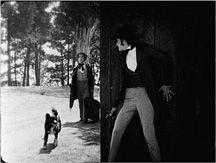
4.165 While Willie ambles along unsuspectingly in the background, one Canfield waits in the foreground to ambush him.
All of these devices for narrative economy considerably unify the film, but some other elements of mise-en-scene function as specific motifs. For one thing, there is the repeated squabble between the anonymous husband and wife. On his way to his estate, Willie passes a husband throttling his wife. Willie intervenes to protect her; the wife proceeds to thrash Willie for butting in. On Willie’s way back, he passes the same couple, still fighting, but studiously avoids them. Nevertheless, the wife aims a kick at him as he passes. The mere repetition of the motif strengthens the film’s narrative unity, but it functions thematically, too, as another joke on the contradictions surrounding the idea of hospitality.
Other motifs recur. Willie’s first hat is too tall to wear in a jouncing railway coach. (When it gets crushed, he swaps it for the trademark flat Keaton hat.) Willie’s second hat serves to distract the Canfields when Willie coaxes his dog to fetch it. There is also a pronounced water motif in the film. Rain conceals from us the murders in the prologue and later saves Willie from leaving the Canfield home after dinner. (“It would be the death of anyone to go out on a night like this!”) A river functions significantly in the final chase. And a waterfall appears soon after Willie’s arrival in the South
(
4.166
).
This waterfall initially protects Willie by hiding him
(
4.167
,
4.168
)
but later threatens both him and the Canfield daughters as they are nearly swept over it (
4.174
).
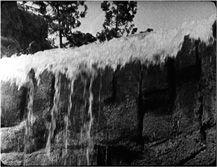
4.166 After an explosion demolishes a dam, the water spills over a cliff and creates a waterfall.
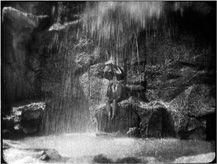
4.167 The new waterfall begins to hide Willie as he sits fishing …
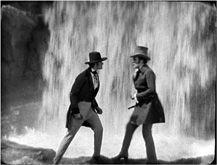
4.168 … and by the time the Canfields rush into the foreground, he is invisible.
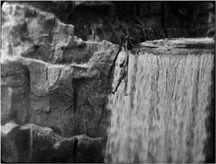
4.174 Willie dangles like a fish on the end of a pole.
Two specific motifs of setting help unify the narrative. First there is the recurrence of an embroidered sampler hanging on the Canfield wall: “Love Thy Neighbor.” It appears initially in the prologue of the film, when seeing it motivates Canfield’s attempt to stop the feud. The sampler reappears at the end when Canfield, enraged that Willie has married his daughter, glances at the wall, reads the inscription, and resolves to halt the years of feuding. His change in attitude is motivated by the earlier appearance of the motif.
The film also uses gun racks as a motif. In the prologue, each feuder goes to his mantelpiece to get his pistol. Later, when Willie arrives in town, the Canfields hurry to their gun rack and begin to load their pistols. Near the end of the film, when the Canfields return home after failing to find Willie, one of the sons notices that the gun rack is now empty. And, in the final shot, when the Canfields accept the marriage and lay down their arms, Willie produces from all over his person a staggering assortment of pistols taken as a precaution from the Canfields’ own supply. Thus mise-en-scene motifs unify the film through their repetition, variation, and development.
Yet
Our Hospitality
is more than a film whose narrative system relates economically to patterns of mise-en-scene. It is a comedy, and one of the funniest. We should not be surprised to find, then, that Keaton uses mise-en-scene for gags. Indeed, so unified is the film that most of the elements that create narrative economy also function to yield comic effects.
The mise-en-scene bristles with many individually comic elements. Settings are exploited for amusement—the ramshackle McKay estate, the Broadway of 1830, the specially cut train tunnel that just fits the old-fashioned train and its smokestack
(
4.169
).
Costume gags also stand out. Willie’s disguise as a woman is exposed by a gap in the rear of his skirt; later, Willie puts the same costume on a horse to distract the Canfields. Most strongly, comedy arises from the behavior of the figures. The railroad engineer’s high kick unexpectedly swipes off his conductor’s hat
(
4.170
).
The elder Canfield sharpens his carving knife with ferocious energy, just inches from Willie’s head. When Willie lands at the bottom of the river, he stands there looking left and right, his hand shading his eyes, before he realizes where he is. Later, Willie scuds down the river, leaping out of the water like a fish and slithering across the rocks.
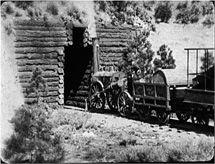
4.169 The tunnel cut to fit the old-fashioned train.
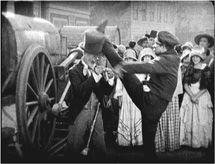
4.170 As the engineer, Keaton’s father, Joe, used his famous high-kick vaudeville stunt for this gag.
Perhaps the only aspect of mise-en-scene that competes with the comic brilliance of the figures’ behavior is the film’s use of deep space for gags. Many of the shots we have already examined function to create comedy as well: The engineer stands firmly oblivious to the separation of train cars from the engine (see
4.163
) just as Willie is unaware that the Canfield boy is lurking murderously in the foreground (
4.165
).
Even more striking, though, is the deep-space gag that follows the demolition of the dam. The Canfield boys have been searching the town for Willie. In the meantime, Willie sits on a ledge, fishing. As the water bursts from the dam and sweeps over the cliff, it completely engulfs Willie (
4.167
). At that very instant, the Canfield brothers step into the foreground from either side of the frame, still looking for their victim (
4.168
). The water’s concealment of Willie reduces him to a neutral background for the movement of the Canfields. This sudden eruption of new action into the scene surprises us, rather than generating suspense, since we were not aware that the Canfield sons were so close by. Here surprise is crucial to the comedy.
However appealing the individual gags are,
Our Hospitality
patterns its comic aspects as strictly as it does its other motifs. The film’s journey pattern often arranges a series of gags according to a formal principle of theme and variations. For instance, during the train trip South, a string of gags is based on the idea of people encountering the train. Several people turn out to watch it pass, a tramp rides the rods, and an old man chucks rocks at the engine. Another swift series of gags takes the train tracks themselves as its theme. The variations include a humped track, a donkey blocking the tracks, curled and rippled tracks, and finally no tracks at all.
But the most complex theme-and-variations series can be seen in the motif of “the fish on the line.” Soon after Willie arrives in town, he is angling and hauls up a minuscule fish. Shortly afterward, a huge fish yanks him into the water
(
4.171
).
Later in the film, through a series of mishaps, Willie becomes tied by a rope to one of the Canfield sons. Many gags arise from this umbilical-cord linkage, especially one that results in Canfield’s being pulled into the water as Willie was earlier.